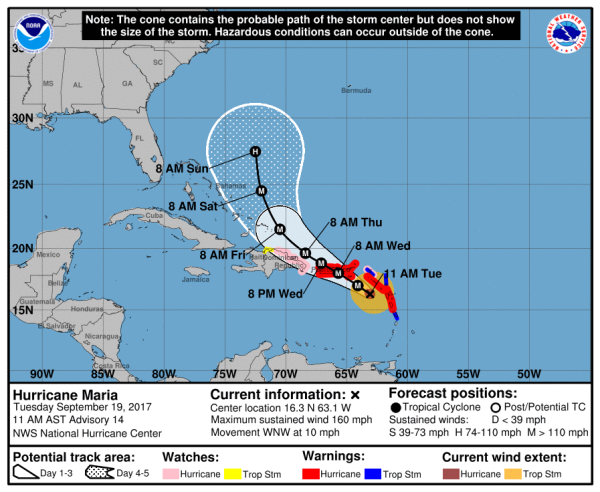Hurricane Maria
Status: Closed
Landfall | Summary
Posting Date: September 19, 2017, 9:30:00 AM
Hurricane Maria is on course to strike Puerto Rico and the Virgin Islands after hitting Dominica on Monday night and Tuesday morning. At Category 5 strength with maximum sustained winds of almost 160 mph, it was the strongest hurricane to ever make landfall in Dominica. The storm weakened briefly to Category 4 as it interacted with Dominica’s mountainous terrain, but has reintensified in the warm waters of the Caribbean, according to the National Hurricane Center (NHC).
As of the NHC’s 11:00 AM ET advisory, Maria is located approximately 115 miles west of Guadeloupe. The storm, traveling west-northwest at about 10 mph, is expected to reach Puerto Rico and the U.S. and British Virgin Islands tonight and into Wednesday as a very dangerous major hurricane, accompanied by life-threatening storm surge that will raise water levels to as much as 7 to 11 feet above normal. A hurricane warning is in effect for Guadeloupe, Dominica, St. Kitts, Nevis, Montserrat, the U.S. Virgin Islands, the British Virgin Islands, Puerto Rico, Culebra, and Vieques.
Torrential rainfall, capable of producing flash floods and landslides, is also expected. Predicted total rainfall amounts are 10 to 15 inches in the U.S. and British Virgin Islands (with isolated pockets of up to 20 inches possible), and 12 to 18 inches in Puerto Rico (with isolated pockets of up to 25 inches possible).
Reported Damage in Dominica and Guadeloupe
According to early reports, Dominica, with a population of 72,000, has been left in ruins by Hurricane Maria. The prime minister stated that severe roof damage is extensive throughout the island, and the roof of his own house was blown off. Phone and internet connection is down as of Tuesday morning, and radio stations across the country are silent. Airports and seaports are expected to be shut for several days.
Maria passed south of Guadeloupe, subjecting it to tropical storm–force winds. Some 80,000 households lost power, and a communications blackout means that damage reports are scarce thus far. Early reports show downed trees and some severely flooded homes and streets. It is noteworthy that Guadeloupe has been a staging ground for the regional aid response to Hurricane Irma in addition to serving as the refuge for people from St. Martin, which was badly hit by Hurricane Irma two weeks ago. The widespread devastation caused by Hurricane Maria could compound the difficulties involved in the recovery process from both these recent disasters.
Preparations in Puerto Rico and the Virgin Islands
Maria is expected to be the first Category 4 or 5 hurricane to make landfall in Puerto Rico in 85 years. The Governor of Puerto Rico has declared a state of emergency and has ordered evacuations for areas prone to floods and landslides, as well as ordering evacuations for certain vulnerable structures. Five-hundred shelters are open across the island, but many are already housing evacuees from other island nations that were devastated by Hurricane Irma. President Trump has also made an emergency declaration to provide federal assistance. On Monday night, Puerto Rico started imposing rationing on water, basic food items, baby formula, batteries, and flashlights. The San Juan Airport will be shut at 7:00 p.m. PM ET on Tuesday night.
The U.S. and British Virgin Islands, already stunned by catastrophic damage to infrastructure, businesses, and homes just two weeks ago from Hurricane Irma, is bracing for another blow. Many of the residents who have not left the devastated islands are in shelters, and it is feared that some of the reconstruction that has just begun will be undone by Maria. Also particularly worrisome is that the vast amount of debris—including glass, metal, downed trees, and parts of houses—has yet to be cleared in the wake of Irma and will become wind-borne projectiles once Maria arrives in full force. Supply missions via air, which the islands have been dependent on, will have to be halted once wind conditions become too dangerous. President Trump has issued a federal disaster declaration for the U.S. Virgin Islands.
Exposure at Risk
Caribbean residential building stock is dependent on exposure location within an island (urban or rural) and regional differences. Older urban structures across the Caribbean exhibit a wide variety of construction materials, but the majority of new residential buildings are made of masonry, reinforced concrete, or both. There are diverse roofing practices across the Caribbean, with the most common type for residential structures being timber with metal roof covering, applied with corrugated or standing seam.
Most commercial structures in the Caribbean are low- to mid-rise, comprising one to six stories. Small apartments, hotels, offices, and other low-rise commercial properties are usually masonry, or reinforced or block concrete. As with residential buildings, there is regional variability.
In Puerto Rico, a large percentage of residential homes are made of reinforced concrete and are thus highly resistant to wind damage. Puerto Rico also has relatively high building code enforcement, which reduces building vulnerability. The “Bunker” style is a concrete building type unique to Puerto Rico that is used for both residential and non-residential structures across the island. Some single-family homes and apartments employ the bunker style, as do various federal court buildings, prisons, and selected neighborhood commercial structures. Bunker buildings have walls made of reinforced concrete, often combined with reinforced masonry. Bunkers have either small “Miami” windows, or highly wind-resistant windows. Bunkers became more prevalent in Puerto Rico following Hurricane Hugo in 1989.
Puerto Rico infrastructure, weakened by the island's decade-long economic slump, may be very vulnerable to flood and wind damage.
Forecast
After passing through Puerto Rico and the Virgin Islands, Hurricane Maria is expected to curve toward the north, passing north of the Dominican Republic. It is expected to maintain major hurricane strength through Saturday morning, and it is currently uncertain whether the storm will impact the U.S. mainland. The AIR tropical cyclone team will continue to monitor the progress of the storm and will provide updates as warranted.